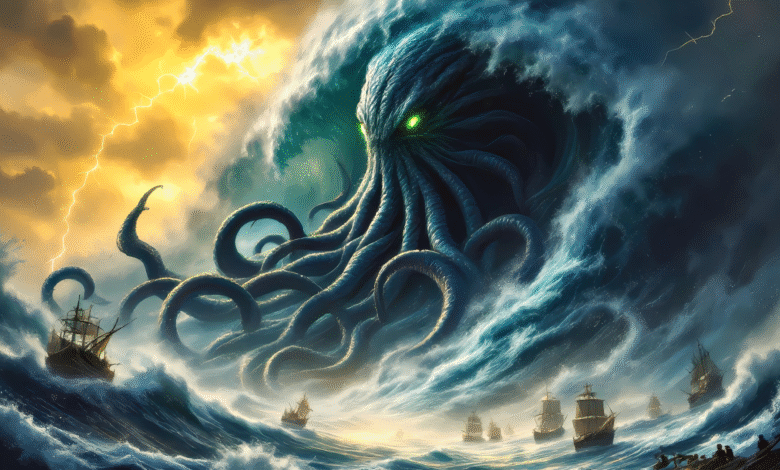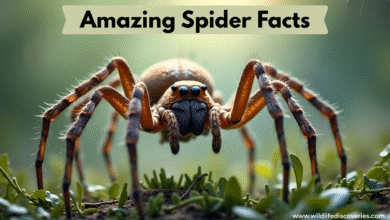
The deep sea remains one of the most mysterious and least explored regions of our planet. Hidden in darkness, thousands of meters beneath the ocean’s surface, a diverse range of extraordinary organisms thrive in extreme conditions. This article delves into the lives of ten unique deep sea creatures, showcasing their strange adaptations and remarkable survival techniques.

The Enigmatic World Beneath the Waves
Life in the deep sea is not easy. Temperatures are near freezing, sunlight never reaches these depths, and pressure can be over a thousand times greater than at the surface. Despite these harsh conditions, a wide array of life has evolved in surprising and bizarre ways. The world of deep sea creatures is unlike any other, filled with alien-like adaptations and haunting beauty.
A Deep Connection: Oarfish and Earthquake Lore
April 2025 – California, USA
In a mysterious turn of events that echoes both science and legend, a rare oarfish measuring over 15 feet in length washed ashore along the coast of Ventura County, California—just days before a powerful 7.0 magnitude earthquake struck the region. While the oarfish is fascinating in its own right, its appearance may hold deeper implications that tie directly into the world of deep sea life.
Image from Wikipedia,

The Deep-Sea Giant
Oarfish (Regalecus glesne) are the longest known bony fish in the ocean, capable of growing over 30 feet (9 meters) in length. They typically inhabit the mesopelagic zone—between 650 and 3,300 feet (200 to 1,000 meters) deep—where few creatures dwell and human encounters are rare. As one of the most elusive deep sea creatures, their sudden appearance always sparks intrigue.
So when one washes ashore, it catches global attention—and stirs up more than just scientific curiosity. It also shines a spotlight on the deep sea as a realm full of unknowns, reminding us of the delicate balance in which these deep sea creatures live.
Legends and Patterns
In Japanese folklore, oarfish are referred to as “Ryugu no tsukai,” or messengers from the sea god’s palace. Legend has it they rise to the surface ahead of major natural disasters like tsunamis or earthquakes.
Such theories gained traction in 2017, when a spate of oarfish sightings in the Philippines preceded a 6.7 magnitude earthquake in Mindanao. The correlation has led some to believe that these creatures can sense undersea tectonic shifts long before humans do.
Similar accounts have come from Mexico, where oarfish strandings were observed before seismic events. Whether it’s coincidence or something more, the recurring pattern has become increasingly difficult to dismiss, further highlighting the mysterious nature of deep sea creatures.
A California Warning?
This latest sighting in California has reignited public interest and scientific debate. The oarfish’s sudden appearance before a strong earthquake adds to a growing body of anecdotal evidence that suggests these animals might react to shifts in the Earth’s crust.
Dr. Helen Navarro, a marine biologist at the Monterey Bay Aquarium Research Institute, weighed in: “We don’t have scientific confirmation yet, but the coincidences are becoming harder to ignore. These creatures may be far more sensitive to Earth’s movements than we understand.”
Coincidence or Clue?
Though many experts remain cautious, they acknowledge that such anomalies should be studied seriously. “This could be nature’s way of speaking,” Dr. Navarro added. “Whether or not oarfish are true seismic indicators, each appearance reminds us how much of the ocean—and the forces beneath it—remain a mystery.”
An Introduction to the Deep-Sea World
With the oarfish story sparking renewed interest in deep sea life, it’s a perfect moment to explore some of its other mysterious inhabitants. From the transparent-headed barreleye fish to the iron-armored scaly-foot snail, these deep sea creatures thrive in conditions as extreme as they are alien. Here are ten other residents of the ocean’s twilight and midnight zones.
1. Barreleye Fish: The Transparent-Headed Marvel
Barreleye fish (Macropinna microstoma) are easily recognized by their transparent domes that encase their tubular eyes. These upward-facing eyes allow the fish to detect prey above them, even in low-light conditions. While its body is dark and typical of deep sea fish, its head is clear, revealing internal structures. It’s one of the most visually bizarre deep sea creatures known to science.
The fish remains motionless while observing its environment, and it can rotate its eyes within its head. This remarkable adaptation helps it pinpoint the location of potential prey with incredible precision. First discovered in 1939, this species was long misunderstood until a live specimen was filmed in 2004.
Image from Wikipedia,

2. Dumbo Octopus: The Graceful Floater
Named after the Disney character for its large, ear-like fins, the dumbo octopus (Grimpoteuthis) is a gentle creature that drifts elegantly above the ocean floor. These deep sea creatures inhabit depths of 3,000 to 4,000 meters but have been spotted even deeper.
Unlike other octopuses, dumbo octopuses do not use jet propulsion to move. Instead, they flap their fins to glide through the water, conserving energy. They feed on copepods, isopods, and bristle worms by enveloping them with their arms and swallowing them whole. Their calm demeanor and unique method of locomotion have fascinated researchers.
Image from oceanfirstinstitute,

3. Brittle Stars: Masters of Regeneration
Closely related to starfish, brittle stars belong to the class Ophiuroidea. These agile invertebrates are known for their long, slender arms and astonishing regenerative abilities. As one of the more flexible deep sea creatures, if a predator captures a brittle star, it can shed an arm and escape—an ability that has evolved over millions of years.
They inhabit crevices and rocky sea beds and are more active at night. Feeding primarily on detritus and plankton, they play a crucial role in nutrient cycling in deep sea ecosystems.
Image from wikipedia,

4. Scaly-foot Snail: The Armored Mollusk
Discovered near hydrothermal vents in the Indian Ocean, the scaly-foot snail (Chrysomallon squamiferum) has captivated scientists with its iron-infused shell. Its scales and outer shell are made of iron sulfide—something unheard of in any other known animal. Among deep sea creatures, this one is a true outlier in terms of body armor.
This snail thrives in toxic environments rich in heavy metals and heated water. Symbiotic bacteria living in its esophagus provide nutrients by oxidizing chemicals emitted by the vents. Its iron armor is believed to provide protection from both predators and harsh environmental conditions.
Image from theguardian,

5. Hatchetfish: Masters of Camouflage
Hatchetfish are named for their thin, silver, hatchet-shaped bodies. These small, bioluminescent fish inhabit the mesopelagic zone, typically between 200 and 1,000 meters deep. These deep sea creatures use light to stay invisible.
Using specialized light-producing organs known as photophores, hatchetfish emit light to counter-illuminate their silhouettes, making them nearly invisible from below. This ability allows them to avoid predators while hunting for zooplankton and small crustaceans.
Image from wikipedia,

6. Midwater Squid: Flashing Hunters
The midwater squid belongs to a group known for their bioluminescent displays. These squids inhabit the midwater zone, a region with minimal light, and use flashing patterns to confuse predators, attract mates, and communicate. Their bioluminescence makes them one of the more dazzling deep sea creatures.
Many species have large eyes adapted for detecting bioluminescent signals. Their diet consists of small fish and other squid. Notably, these squids can control the intensity and frequency of their flashes, a skill that helps them survive in the dark abyss.
Image from wikipedia,

7. Anglerfish: The Luring Predator
Perhaps one of the most iconic deep sea creatures, the anglerfish uses a glowing lure to attract prey. This bioluminescent tip, located at the end of a modified dorsal spine, is dangled in front of the anglerfish’s mouth. Unsuspecting prey are drawn in, only to be devoured.
Females are significantly larger than males. Males, once they locate a female, latch onto her body and eventually fuse with her, becoming a permanent reproductive partner. This bizarre mating system is a remarkable adaptation to the sparse population density of the deep sea.
Image from wikipedia,

8. Pelican Eel: The Expanding Gulper
Pelican eels, also called gulper eels, are known for their massive, expandable jaws. These jaws can stretch wide enough to engulf prey much larger than the eel itself. Among deep sea creatures, its feeding strategy is one of the most extreme.
Despite its fearsome appearance, the pelican eel is not aggressive and feeds mainly on crustaceans and small fish. It is rarely seen by humans, which adds to the mystery surrounding this strange creature.
9. Black Swallower: The Ultimate Gutsy Feeder
The black swallower (Chiasmodon niger) is a small fish capable of consuming prey several times its own size. Its stomach can expand dramatically, allowing it to engulf animals far larger than itself. This rare trait places it among the most daring deep sea creatures.
This fish lives at depths of up to 2,500 meters and is equipped with sharp, curved teeth. Occasionally, it bites off more than it can chew—literally. Swallowing prey too large can cause the fish’s stomach to rupture, leading to its death. Still, its daring feeding strategy is a fascinating evolutionary trait.
Image from wikipedia,

10. Giant Isopod: The Deep Sea Scavenger
To round out our list, we introduce the giant isopod (Bathynomus giganteus), a distant relative of the pill bug. These armored crustaceans can grow up to 50 cm in length and inhabit the cold, dark depths of the Atlantic and Pacific Oceans. As one of the more visually startling deep sea creatures, it certainly stands out.
Feeding primarily on dead whales, fish, and squid, giant isopods play an important role in the ocean’s cleanup crew. They can survive for years without food and have been observed going into a state of torpor to conserve energy. When food is plentiful, they gorge themselves in gluttonous feasts.
Life Finds a Way: Adaptations and Survival
Each of these deep sea creatures showcases the incredible ways in which life has adapted to the deep sea’s unforgiving environment. Bioluminescence, transparency, regeneration, armor, and extreme feeding strategies are all tools in their survival kit.
Many of these adaptations have inspired biomimicry in science and engineering. For example, the transparent head of the barreleye fish has intrigued optical engineers, and the tough shell of the scaly-foot snail has been studied for use in military armor.
Conclusion
Though much remains unknown about the deep ocean, the creatures already discovered suggest a world more alien than anything imagined in science fiction. These ten deep sea marvels—each stranger and more awe-inspiring than the last—are a testament to life’s resilience and creativity. Exploration continues, and with it, the promise of uncovering more strange and beautiful deep sea creatures that thrive in the darkness. The ocean’s depths remain a final frontier, rich with secrets waiting to be revealed.




